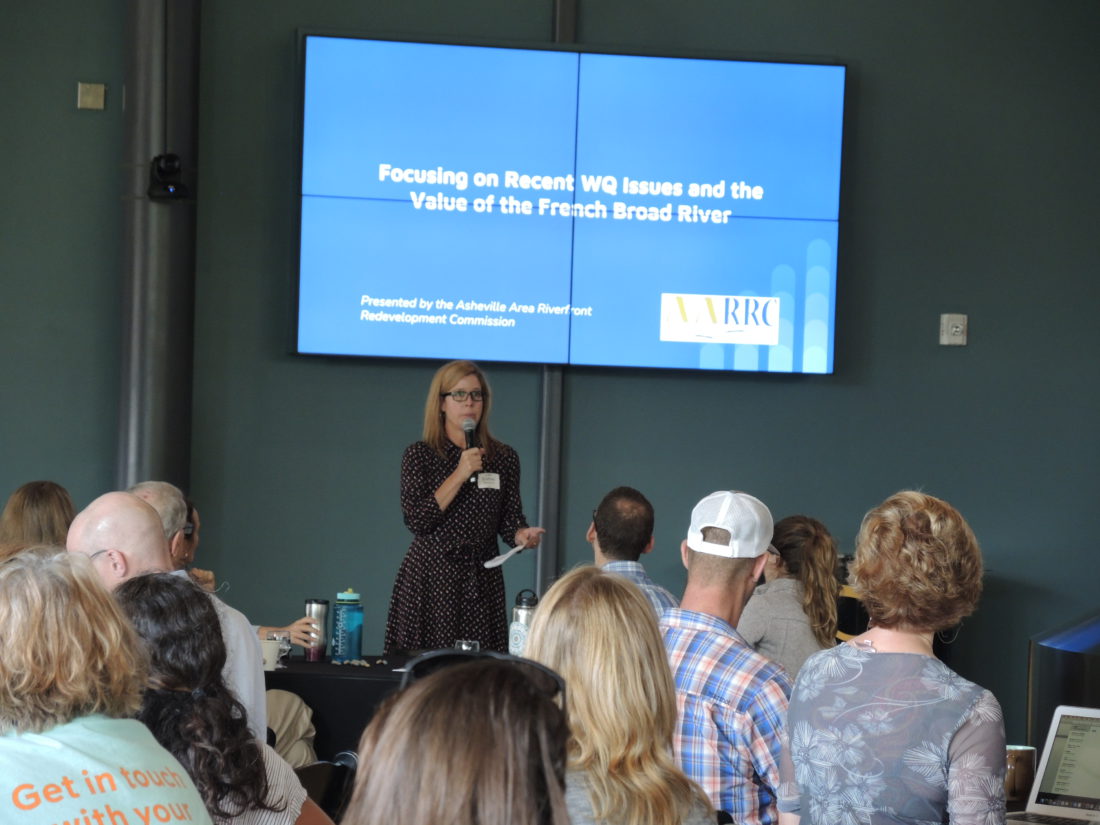“The [French Broad] River belongs to no one in particular, so it belongs to all of us. We’re all responsible for what’s happening, good or bad.”
That’s how Anne Keller, a member of the Asheville Area Riverfront Redevelopment Commission, set the stage for the River Improvement and Protection Summit held Sept. 8. About 100 people attended the special event — the first of its kind hosted by the AARRC — at New Belgium Brewing Co.
The gathering had been prompted by two reports released earlier this year. The first was a study, commissioned by the French Broad River Partnership and led by economist Steve Ha of Western Carolina University, that placed an annual value of $3.8 billion on the French Broad. The river, Keller explained, attracts tourists and residents, provides recreation opportunities, hosts endangered species and supports more than 35,000 jobs. But its quality and cleanliness can impact each of those benefits.
The second report, released by the N.C. Department of Environmental Quality, added 19 miles of the French Broad from Long Shoals to Craggy Dam to its list of “impaired” waterways. High levels of fecal coliform bacteria, organisms found in the intestines and feces of humans and animals, were detected in the river. Hominy Creek, Cane Creek, Town Branch and much of the Swannanoa were also on the list.
The high levels of bacteria, combined with “increased development and impacts of climate change,” are cause for concern, Keller said. She cited data indicating a 27% increase in regional “extreme rainfall” between 1958 and 2016 and a 13% population increase for Asheville and Buncombe County over the past decade.
“If we don’t address some of the challenges and protect our river now, it’s not going to get better,” Keller told the summit.
Leading change
The 14-member AARRC provides recommendations to City Council for “the continued development and sustainability of the regional riverfront” and “for effective management of the public resources.” By convening a diverse group of community members at the summit, including small-business owners, nonprofit leaders, lawyers, real estate agents and Council members, the commission hoped to identify the most pressing issues affecting area waterways and begin to strategize solutions.
“Our ultimate goal is to galvanize stakeholders so that we can all contribute to making things better through the development of a coordinated plan,” said AARRC Chair Darren Green.
The AARRC meeting comes at a pivotal time for the region’s long-term policymaking. Buncombe County Commissioner Parker Sloan told summit attendees that the county intends to finish its Comprehensive Plan 2043 by the end of the year. At that point, he said, “I and the rest of my colleagues on the commission will spend all next year thinking about and rewriting and developing and adjusting every zoning and land use regulation that Buncombe County has.”
Sloan told the crowd that the board’s Environmental and Energy Stewardship Subcommittee, of which he is a member, will be developing water quality goals by January. He encouraged community members to reach out to their commissioners and share feedback over the coming months.
Mayor Esther Manheimer was also at the meeting, along with Council members Sage Turner and Kim Roney. “I know all of us collectively are concerned about water quality in our community and in our region,” Manheimer told the audience. “This is going to require a lot of work and collaboration with one another, and the city is excited to continue to collaborate and partner with all of you to make a lot of these things come true that you’re going to be talking about today.”
Storm’s a brewin’
The bulk of the summit consisted of roundtable discussions between AARRC commissioners and groups of about 10 attendees. The groups spent an hour discussing issues affecting water quality, how to best address those challenges and “roadblocks” to creating change.
During the small group Xpress observed, as well as in an informal poll of all attendees taken at the end of summit, stormwater management was a key concern. Heavy rainfall can wash unwanted debris into waterways, and Eric Bradford, director of operations at Asheville GreenWorks, said most of the fecal coliform in the French Broad comes from farmland runoff. “Cattle in bottom properties that cannot be developed, right there next to the river … that’s actually a huge amount that we’re receiving,” he told a small group.
Accordingly, working with “farmers, forestry and cattle people to improve practices,” led the informal poll on how the city can better address water quality issues. Groups also talked about incentivizing “climate-friendly development” to encourage developers to build more sustainably.
“This is the beginning,” Keller said. “This is just the first conversation to try to get people interested in and aware of some of the challenges and needs and start talking about how we can do better.”




Before you comment
The comments section is here to provide a platform for civil dialogue on the issues we face together as a local community. Xpress is committed to offering this platform for all voices, but when the tone of the discussion gets nasty or strays off topic, we believe many people choose not to participate. Xpress editors are determined to moderate comments to ensure a constructive interchange is maintained. All comments judged not to be in keeping with the spirit of civil discourse will be removed and repeat violators will be banned. See here for our terms of service. Thank you for being part of this effort to promote respectful discussion.